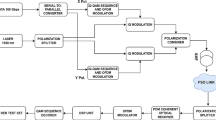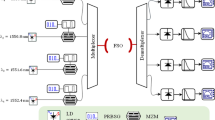Abstract
Optical wireless communication is regarded as the next-generation high-speed technology. It has demonstrated its capability to deliver data faster than any other state-of-the-art wireless communication technique. This technology has drawn attention as a means of implementing reliable high capacity outdoor systems that cannot be implemented by conventional fiber optics. It has emerged recently as an efficient solution to match the larger bandwidth and high data rates requirement of the upcoming wireless communication systems. However, although FSO (free space optics) system has many appealing features, it has rather disappointing performance for long links due to the degrading effects of atmospheric turbulence-induced fading. In the presence of such type of performance impairments, the received signal exhibits random intensity fluctuations, which increase the BER (bit error-rate), where the severe weather conditions can have a detrimental impact on the performance, which may result in an inadequate availability. The MIMO wireless optical procedure, in which the spatial dimensions are used to improve the reliability and spectral efficiency of point-to-point links, provides a promising approach to mitigate turbulence effects due to its powerful performance enhancing capabilities.
In this paper, we investigate a terrestrial atmospheric FSO communication system operating under the influence of strong atmospheric turbulences. Additionally, the MIMO technique with equal gain combining (EGC) is used in this work to enhance the data rate of the proposed system. Atmospheric turbulence impacts are modeled as a lognormal channel with due regard for geometric losses. With the use of NRZ line coding, an FSO highly sensitive receiver using either avalanche photodetector (APD) or PIN is designed and simulated for best system performance. The preference is achieved by using Bessel and Gaussian filters. It has been found that APD receiver using Gaussian filter is suitable for long-range links with APD gain value of 3. Also, the selection of APD gain is critical to the system performance. In addition, the optimal value of APD gain required for best system performance decreases as the size of the MIMO technique increases. The achievable performance improvements including received power levels, BER and Q-factor are also discussed. The results show that the system with optical amplifier at the transmitter gives an optimum performance. In addition the system performance is enhanced in most weather conditions by using an amplified 2×2 MIMO-FSO system with booster amplifier.
Similar content being viewed by others
References
Z. Ghassemlooy, W. Popoola, S. Rajbhandari, Optical Wireless Communications: System and Channel Modelling with MATLAB (CRC Press, Taylor & Francis Group, 2017).
S. Das, H. Henniger, B. Epple, C. I. Moore, W. Rabinovich, R. Sova, D. Young, “Requirements and challenges for tactical free-space lasercomm,” Proc. of IEEE Military Communications Conf., 16–19 Nov. 2008, San Diego, CA, USA (IEEE, 2008), pp. 1–10. DOI: 10.1109/MILCOM.2008.4753049.
A. O. Aladeloba, A. J. Phillips, M. S. Woolfson, “Performance evaluation of optically preamplified digital pulse position modulation turbulent free-space optical communication systems,” IET Optoelectronics 6, No. 1, 66 (2012). DOI: 10.1049/iet-opt.2011.0029.
M. Uysal, J. Li, M. Yu, “Error rate performance analysis of coded free-space optical links over gamma-gamma atmospheric turbulence channels,” IEEE Trans. Wireless Commun. 5, No. 6, 1229 (2006). DOI: 10.1109/TWC. 2006.1638639.
Mohamed B. El-Mashade, Moustafa H. Aly, Ahmed H. Toeima, “Performance evaluation of FSO system with MIMO technique in different operating environments,” Phys. Sci. Int. J. 7, No. 1, 33 (2015). DOI: 10.9734/PSIJ/2015/17212.
G. Yang, M.-A. Khalighi, S. Bourennane, Z. Ghassemlooy, “Approximation to the sum of two correlated gamma-gamma variates and its applications in free-space optical communications,” IEEE Wireless Commun. Lett. 1, No. 6, 621 (2012). DOI: 10.1109/WCL.2012.091312.120469.
M. Abaza, R. Mesleh, A. Mansour, el-Hadi Aggoune, “Performance analysis of MISO multi-hop FSO links over log-normal channels with fog and beam divergence attenuations,” Optics Commun. 334, 247 (2015). DOI: 10.1016/j.optcom.2014.08.050.
G. Abbas, E. Ahmed, W. Aziz, S. Saleem, Q. ul Islam, “Performance enhancement of multi-input multi-output (MIMO) system with diversity,” Int. J. Multidisciplinary Sci. Eng. 3, No. 5, 8 (2012).
R. Mesleh, R. Mehmood, H. Elgala, H. Haas, “Indoor MIMO optical wireless communication using spatial modulation,” Proc. of IEEE Int. Conf. on Communications, ICC’10, 23-27 May 2010, Cape Town, South Africa (IEEE, 2010), pp. 1–5. DOI: 10.1109/ICC.2010.5502062.
Mohamed B. El Mashade, Ahmed H. Toeima, Moustafa H. Aly, “Receiver optimization of FSO system with MIMO technique over log-normal channels,” Optoelectron. Adv. Mat. 10, No. 7-8, 497 (2016). URI: https://oamrc.inoe.ro/index.php?option=magazine&op=view&idu=2857&catid=97.
H. Shaban, S. D. A. El Aziz, M. H. Aly, “Probability of error performance of free space optical systems in severe atmospheric turbulence channels,” Proc. of 10th Mediterranean Microwave Symp., MMS’2010, 25-27 Aug. 2010, Guzelyurt, Cyprus (IEEE, 2010), pp. 355–359. DOI: 10.1109/MMW.2010.5605154.
C. Singh, J. John, Y. N. Singh, K. K. Tripathi, “A review of indoor optical wireless systems,” IETE Tech. Rev. 19, No. 1-2, 3 (2002). DOI: 10.1080/02564602.2002.11417006.
K. Kiasaleh, “Performance of APD-based, PPM free-space optical communication systems in atmospheric turbulence,” IEEE Trans. Commun. 53, No. 9, 1455 (2005). DOI: 10.1109/TCOMM.2005.855009.
J. Yan, Z. Zheng, W. Hu, A. Xu, “Improved performance of M-ary PPM free-space optical communication systems in atmospheric turbulence due to forward error correction,” Proc. of 10th Int. Conf. on Communication Technology, 27-30 Nov. 2006, Guilin, China (IEEE, 2006), pp. 1–4. DOI: 10.1109/ICCT.2006.341961.
Steve Hiranovic, Wireless Optical Communication Systems (Springer, New York, 2004).
H. Manor, S. Arnon, “Performance of an optical wireless communication system as a function of wavelength,” Appl. Opt. 42, No. 21, 4285 (2003). DOI: 10.1364/AO.42.004285.
X. Liu, “Free-space optics optimization models for building sway and atmospheric interference using variable wavelength,” IEEE Trans. Commun. 57, No. 2, 492 (2009). DOI: 10.1109/TCOMM.2009.02.070089.
Nazmi A. Mohammed, Amr S. El-Wakeel, Amin Malekmohammadi, Moustafa H. Aly, “Performance evaluation of FSO link under NRZ-RZ line codes, different weather conditions and receiver types in the presence of pointing errors,” Open Electrical Electronic Eng. J. 6, 28 (2012). DOI: 10.2174/1874129001206010028.
X. Tang, S. Rajbhandari, W. O. Popoola, Z. Ghassemlooy, E. Leitgeb, S. S. Muhammad, G. Kandus, “Performance of BPSK subcarrier intensity modulation free-space optical communications using a log-normal atmospheric turbulence model,” Proc. of Symp. on Photonics and Optoelectronic, SOPO, 19-21 Jun. 2010, Chengdu, China (IEEE, 2010), pp. 1–4. DOI: 10.1109/SOPO.2010.5504014.
Mohamed B. El Mashade, Ahmed H. Toeima, Moustafa H. Aly, “Regenerated spatial diversity performance of wireless optical communication over strong turbulent atmospheric channel,” J. Appl. Physical Sci. Int. 5, No. 1 (2016). URI: http://www.ikpress.org/abstract/4677.
M. L. Baedke, “Performance analysis of multipulse PPM on MIMO free-space optical channels,” Ph.D dissertation, School of Engineering and Applied Science (University of Virginia, Virginia, USA, 2004).
Sadia, S. Majumder, “Performance analysis of a MIMO FSO system in presence of pointing error,” Proc. of 2011 Int. Conf. on Computer Communication and Management, ICCCM 2011, 2-4 May 2011, Sydney, Australia (Sydney, 2011). ISBN 978-1-84626.
Author information
Authors and Affiliations
Corresponding author
Additional information
Original Russian Text © M.B. El Mashade, A.H. Toeima, 2018, published in Izvestiya Vysshikh Uchebnykh Zavedenii, Radioelektronika, 2018, Vol. 61, No. 4, pp. 183–208.
About this article
Cite this article
El Mashade, M.B., Toeima, A.H. Performance Characterization of Spatial Diversity Based Optical Wireless Communication over Atmospheric Turbulence Channels. Radioelectron.Commun.Syst. 61, 135–152 (2018). https://doi.org/10.3103/S0735272718040015
Revised:
Published:
Issue Date:
DOI: https://doi.org/10.3103/S0735272718040015




